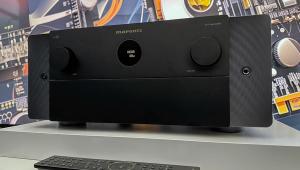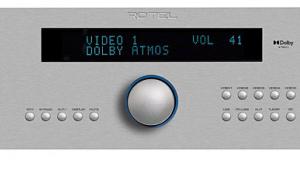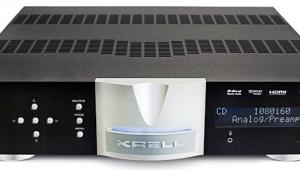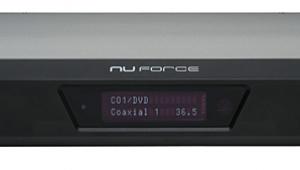Marantz AV8805 A/V Surround Processor Review Page 2
One thing Marantz hasn’t updated is its best-in-class user interface, one that I find to be extremely intuitive and easy on the eyes. When powering up for the first time, you are greeted by a guided setup that walks you through the installation. First, you tell the processor how many components you’re using. Next, you’re instructed to connect the included Audyssey microphone to the unit’s front so that MultiEQ XT32 equalization can work its magic.
 The effect that Audyssey has on your particular room will, of course, vary. In my case, very little help was needed since my room is fully treated and my four subwoofers get their own equalization through a MiniDSP processor using the freeware software RoomEQ Wizard. I did make a point of doing some listening tests with Audyssey enabled, but I ultimately preferred it switched off. You may feel differently.
The effect that Audyssey has on your particular room will, of course, vary. In my case, very little help was needed since my room is fully treated and my four subwoofers get their own equalization through a MiniDSP processor using the freeware software RoomEQ Wizard. I did make a point of doing some listening tests with Audyssey enabled, but I ultimately preferred it switched off. You may feel differently.
The AV8805’s remote is of the learning variety but can’t really compare with more powerful aftermarket remotes like those from Harmony or URC. Thankfully, it’s backlit and has the capability to operate all three zones by toggling the Zone Select button located at the top. Like the remotes included with its predecessors, the AV8805’s IR sensor has a very narrow receiving range and doesn’t always respond to commands unless the remote is pointed directly at it and in close proximity (less than 10 feet). I was able to overcome this issue by using a URC MX-980 remote that communicates via RF with a base station that in turn sent commands to the Marantz via its rear-panel IR input. Given the audience that this pre/pro caters to, I assume most users will do something similar or operate it via an IP interface.
The AV8805’s arrival coincided with my review of an M&K Sound S150 speaker system (October/November 2018 issue) consisting of three S150 speakers across the front coupled with four S150T Tripole speakers to round out the bed level. Overhead were four Atlantic Technology IC-6-OBA in-ceiling speakers; below were four subwoofers finely tuned with the MiniDSP processor. Amplification was provided by two ATI class-D amplifiers with NCore modules: the AT527NC and AT524NC. While I would have loved to tap more channels and test a full 13-speaker configuration, my room is too narrow for wide speakers and too shallow to accommodate additional ceiling speakers. Plus, my wife has reached the tipping point when it comes to room upgrades.
Performance
Watching movies with the AV8805 was a reference-quality experience from beginning to end. Surround effects moved through the room seamlessly—whether from Dolby Atmos or DTS:X discs, or upmixed via DSU (Dolby Surround Upmixing) from legacy codecs. The Jumanji: Welcome to the Jungle UHD Blu-ray counts among my favorite discs released in 2018 due to its wildly entertaining screenplay and perfect casting. Also, its Dolby Atmos track is to die for! Heard via the AV8805 on my system, the overhead speakers really came alive when a character respawned and was dropped back into the group. Coupled with gunshots ripping through the room, foundation-shaking explosions, and dialog that remained consistently clear and intelligible, the experience rivalled that of visiting a good movie theater.

One Republic: Live in South Africa is a great concert Blu-ray for fans of the popular group. While the band’s music isn’t revolutionary, it’s well-composed and will have you tapping your toes. Both my kids played cello growing up, so it’s nice to hear a band that integrates orchestral instrument into their songs. Listening to the cello solo that opens the song “Secrets,” I had the experience of sitting front row at the concert. Every pull of the bow across the strings sounded so vivid and realistic that it was hard to believe I was in my home theater listening to a DTS-HD Master Audio track.
Playing the Unamas String Quintet’s rendition of Franz Schubert’s No. 14 in D minor Death and the Maiden from a Dolby Atmos demo disc took things up another notch. This track sounded even better than it did on the Marantz AV8802A, with increased body and mid-range heft. Furthermore, the imaging was damn near perfect, which had the effect of making the speakers disappear into the room.
One of the most impressive things about Marantz’s previous flagship processor was its performance with two-channel music. As expected, the next-generation AV8805 has upped the ante here as well. One reference track I use for audio comparisons is “Second Choice,” from the Marti Jones album Live at Spirit Square. This song features just a bass guitar, bongo drums, and Jones’ fabulous voice. With the Marantz, the bass response was tight and clean and didn’t hang in the room longer than it should. Elements in the recording such as the bass guitarist’s fingers sliding along the strings also came through with crystal clarity. Subtle audio cues like these can get lost with inferior equipment, but the AV8805 passed every audio hurdle I put in front of it.

Conclusion
I’m a big advocate of Dolby Atmos and DTS:X, and whenever someone experiences those formats in my home theater they are blown away by how much the overhead effects draw you into the movie experience. While I have no desire to add more speakers to my relatively small theater, or to configure the room for Auro-3D, I know there are some enthusiasts clamoring for a fully immersive home theater audio experience that doesn’t require buying a $20,000 dedicated processor. For those folks, I’m happy to report that Marantz’s new AV8805 sounds great and checks every high-end home theater box at one-quarter the price of current uber-expensive audio processor solutions.




























































